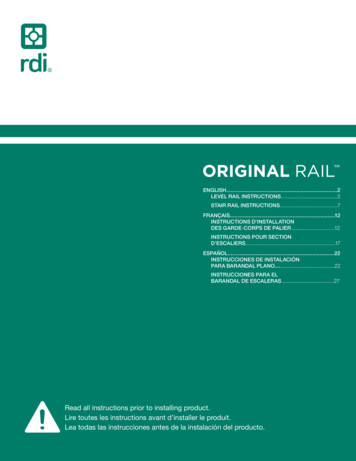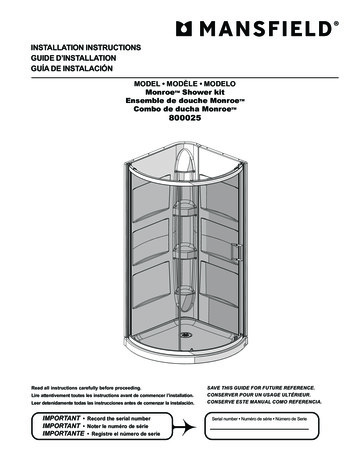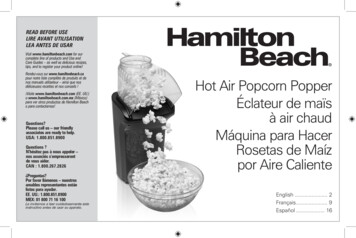
Transcription
ENGLISH.2LEVEL RAIL INSTRUCTIONS.2STAIR RAIL INSTRUCTIONS.7FRANÇAIS.12INSTRUCTIONS D’INSTALLATIONDES GARDE-CORPS DE PALIER.12INSTRUCTIONS POUR SECTIOND’ESCALIERS.17ESPAÑOL.22INSTRUCCIONES DE INSTALACIÓNPARA BARANDAL PLANO.22INSTRUCCIONES PARA ELBARANDAL DE ESCALERAS.27Read all instructions prior to installing product.Lire toutes les instructions avant d’installer le produit.Lea todas las instrucciones antes de la instalación del producto.
ENGLISHLEVEL RAILWarning: Always wear safety goggles.RDI has obtained a PFS TECO research report on the International Building Code and the International Residential Codes . For a full report,see PFS Evaluation Report No. RR-0115 at www.pfsteco.com.NOTE: Check with your local building code office for design load requirements for guard rails and bottom space requirements. All supportingstructures should be built in accordance with applicable building codes.LIMITED WARRANTYTo obtain and review a copy of the warranty please go to: rdirail.com/warranty. You can also contact (877) 420-7245 or write to:RDI Warranty, 545 Tilton Road, Egg Harbor City, NJ 08215 to obtain a copy of the warranty.COMPONENT LIST:TOOLS NEEDED:Check the kit to ensure all components are included.BACDEA) Aluminum Bottom Rail Stiffener – 1– Safety gogglesB) Vinyl Bottom Rail – 1– Tape measureC) Aluminum Top Rail Stiffener – 1– PencilD) Vinyl Top Rail – 1– LevelE) Balusters – (see chart below)– Power screwdriver/drillF) Top Mounting Bracket – 2– Power sawG) Bottom Mounting Bracket – 2– Straight edge/ruler/triangleH) Snap on Bracket Covers – 6FGI) Rail Mounting Screws – 12J) Rail Mounting Set Screws – 4HIJ2RAILLENGTHSQUARE BALUSTERS PER KITTURNED BALUSTERS PER KITROUND BALUSTERSPER KITGLASS BALUSTERSNEEDED PER KIT4' Kit9N/AN/AN/A6' Kit14141598' Kit1919201210' Kit242426N/A
ENGLISH1.2.3.Prepare all posts and mounting surfacesbefore installation.Establish the height of the lower rail usingblocks for the desired bottom space.Measure from the mounting surface to thefirst baluster hole on each end (Fig. 2) andadjust until these dimensions are equal.Place the bottom rail across the openingwhere it is to be installed (Fig. 1).Tip: Standard Original Rail measures 36" inheight with a 2" space below the bottom rail.Use 2" blocks to establish bottom rail height.Trace the post onto the bottom rail and mark1/8" short at each end to allow for expansion(Fig. 3).Tip: If all of your mounting surfaces areplumb, transfer your measurements andbaluster layout from the bottom rail to the toprail (Fig. 4).NOTE: A minimum of 1¼" from the edge of thefirst baluster to the end of the rail is necessaryto accommodate the mounting brackets.(Fig. 2)(Fig. 3)(Fig. 1)(Fig. 4)3
ENGLISHLEVEL RAIL CONTINUED4.5.6.Cut each end of the rail at the measurementdetermined in Step 3 (Fig. 5).Place rail with brackets between posts asshown in Figure 7.Insert a baluster into each routed hole of thebottom rail (Fig. 10).Tip: If using a power saw, a carbide tip bladeof at least 60 teeth is recommended.Pre-drill the holes (Fig. 8) for the mountingbrackets to avoid stripping the stainless steelscrews and secure in place using the railmounting screws (item I) from component list(Fig. 9).NOTE: Each kit with vinyl balusters contains2 tabbed balusters; space them evenly intoeach section.Place a bottom mounting bracket on eachend of the bottom rail with the flat side facingthe rail ends (Fig. 6).NOTE: The looped part of the aluminumP-channel must be facing away (down) fromthe baluster holes while the flat side of theP-channel must be facing the outside of thedeck when mounted.(Fig. 7)(Fig. 5)(Fig. 8)(Fig. 6)4(Fig. 9)(Fig. 10)
ENGLISH7.8.9.Cut the top rail following the sameprocedure that you used in steps 3 and 4for the bottom rail.Place a T-shaped top mounting bracket (itemF) on each end of the top rail, with the flatside facing the mounting surface.Beginning at one end of the rail section,(Fig. 12) insert each baluster installed in Step6 into the corresponding baluster hole intothe top rail.Make sure that the aluminum T-channel isflush with the end of the vinyl top rail (Fig. 11).To allow for baluster expansion, raise the toprail approximately 1/8". Pre-drill the holes (Fig.13) for the mounting brackets to avoid strippingthe stainless steel screws and secure in placeusing supplied screws (I) (Fig. 14).(Fig. 12)(Fig. 13)(Fig. 14)(Fig. 11)5
ENGLISHLEVEL RAIL CONTINUED10.11.Secure the top rail to mounting bracketsusing supplied set screws (J) as shown inFigure 15.Check entire installation for accuracy beforesnapping snap on bracket covers (H) for topand bottom brackets (Fig. 16) into place.Repeat Steps 1 through 10 for each railsection.NOTE: Bracket covers press-fit onto thebrackets perpendicular to the post; theycannot be slid into place.(Fig. 15)(Fig. 15)6
ENGLISHSTAIR RAILWarning: Always wear safety goggles.NOTE: Check with your local building code office for design load requirements for guard rails and bottom space requirements. All supportingstructures should be built in accordance with applicable building codes.LIMITED WARRANTYTo obtain and review a copy of the warranty please go to: rdirail.com/warranty. You can also contact (877) 420-7245 or write to:RDI Warranty, 545 Tilton Road, Egg Harbor City, NJ 08215 to obtain a copy of the warranty.COMPONENT LIST:TOOLS NEEDED:Check the kit to ensure all components are included.A) Aluminum Bottom Rail Stiffener – 1– Safety gogglesB) Vinyl Bottom Rail – 1– Tape measureC) Aluminum Top Rail Stiffener – 1– PencilD) Vinyl Top Rail – 1– LevelE) Balusters – (See chart below)– Power screwdriver/drillF) Bottom Rail Mounting Bracket – 2– Power sawBADCEF.A) Low Angle Bracket Insert – 2FF.B) High Angle Bracket Insert – 2G) Top Rail Bottom Mounting Bracket – 1GH) Top Rail Top Mounting Bracket – 1I) Snap on Bracket Covers – 2HJ) Top Rail Mounting Screws,3" length – 4K) Bottom Rail Mounting Screws,2" length – 8F.AIF.BJKLL) Top Rail Set Screws, 1" length – 4Endurance Original Rail stair brackets do notneed to be cut, and work at angles between32 and 38 .RUN (INCHES)M) Press-in Plugs – 2726256.5363433323129282727MKIT LENGTHSQUARE BALUSTERSPER KITTURNED BALUSTERSPER KITROUND BALUSTERSPER KITGLASSBALUSTERSPER 63534337
ENGLISHSTAIR RAIL CONTINUED1.2.Prepare all posts and mounting surfacesbefore installation.Temporarily secure a plank on the nosesof the stairs between the posts onto whichyou are installing the stair rail. (Fig. 1) Thethickness of the plank will determine thespace between the stairs and the bottom rail.Place the bottom rail, baluster holes facingup, on the plank with the sticker reading“This end at top.” at the top post (Fig. 2).Slide the rail up or down until the balusterhole spacing is even on each end (Fig. 3).Trace the post onto the rail and mark 1/8" shortat each end to allow for expansion (Fig. 4).Now cut the rail to fit (Fig. 5).NOTE: A minimum of 2 3/8" from the edgeof the first baluster to the end of the rail isnecessary to accommodate the mountingbrackets.Tip: If using a power saw, a carbide tip bladeof at least 60 teeth is recommended.(Fig. 3)(Fig. 1)(Fig. 4)(Fig. 2)8(Fig. 5)
ENGLISH3.4.5.If installing at an angle between 35 and 38degrees, snap a small insert (F.B) into eachbottom bracket (Fig. 6).Orient the bracket being used at the top ofthe stair with the insert placed inside thebottom of the bracket and the bracket beingused at the stair bottom with the insert at thetop of the bracket (Fig. 8).Insert a baluster into each of the first and lastbaluster holes of the bottom rail, and set thetop rail in place by inserting them into thecorresponding holes (Fig. 11).If installing at an angle between 32 and 34degrees, lower snap a large insert (F.A) intoeach bottom bracket (Fig. 7).Slide the brackets onto the rail with thebracket’s flat side facing the rail ends. Set rail inplace and pre-drill at all holes in the mountingbrackets to avoid stripping the stainless steelscrews (Fig. 9) and secure in place using itemK from component list (Fig. 10).Place the top rail inside of the posts to measureaccurately. Adjust for plumb.Trace the posts onto the rail and mark 1/8" shortto allow for expansion (Fig. 12).NOTE: The looped part of the aluminumP-channel must be facing away (down)from the baluster holes; the flat side of theP-channel must be facing the outside of thedeck when mounted.(Fig. 8)Bracket used atTop of StairBracket used atBottom of Stair(Fig. 6)(Fig. 9)(Fig. 7)(Fig. 10)(Fig. 11)(Fig. 12)9
ENGLISHSTAIR RAIL CONTINUED6.7.8.Cut the top rail to fit (Fig. 13).Slide a top rail mounting bracket in placewith flat side facing the mounting post. Topstair mounting bracket (H) should be at top ofthe stair and bottom stair mounting bracket(G) should be at the bottom (Fig. 14).Insert a baluster into each rout of thebottom rail.NOTE: Each kit with vinyl balusters contains2 tabbed balusters; space them evenly intoeach section.Set the top rail in place by inserting thefirst baluster (at the upper post) in thecorresponding rout of the top rail, and worktoward the bottom (Fig. 15).(Fig. 13)10(Fig. 14)(Fig. 15)
ENGLISH9.10.11.To allow for baluster expansion, raise the toprail approximately 1/8". Pre-drill the holes forthe mounting brackets to avoid stripping thestainless steel screws (Fig. 16).Secure top railing to brackets using providedset screws (L) as shown in figure 18.Check entire installation for accuracy beforesnapping snap on bracket covers (Fig. 19)into place, and inserting the button plugs intothe bottom brackets (Fig. 20).Secure top rails in place using provided top railmounting screws (J) into both sides of eachbracket at the top and bottom post (Fig. 17).(Fig. 16)(Fig. 17)(Fig. 19)(Fig. 18)(Fig. 20)11
RAMPE AU NIVEAUAvertissement: Toujours porter des lunettes de sécurité.RDI a obtenu un rapport d’évaluation de la CCI sur le Code International de ConstructionMD et les Codes Internationaux RésidentielsMD. Pourun rapport complet, voir le rapport d’évaluation ICC-ES # ESR-1849.REMARQUE: Vérifiez auprès de votre code du bâtiment lmunicipal pour connaitre ce qui est exigé en matière de charge nominale pour les gardecorps et quelle hauteur est exigée sous les garde-corps. Toutes les structures d’appui doivent être construites conformément aux codes dubâtiment en vigueur.GARANTIE À VIE LIMITÉEPour plus de détails sur la garantie, visiter le: rdirail.com/warranty. Vous pouvez également téléphoner le (877) 420-7245 ou écrire àRDI Warranty, 545 Tilton Road, Egg Harbor City, NJ 08215 pour obtenir une copie de la garantie.LISTE DES COMPOSANTES:OUTILS REQUIS:Vérifier votre ensemble pour s’assurer que tout le matériel est inclus.A) Renfort de traverse inférieure enaluminium – 1BAFRANÇAISB) Traverse inférieure en vinyle – 1CC) Renfort de traverse supérieure enaluminium – 1DE– Ruban à mesurer– Crayon– NiveauD) Traverse supérieure en vinyle – 1– Tournevis électrique / PerceuseE) Balustres – (voir tableau ci-dessous)– Scie électriqueF) Support de montage supérieur – 2F– Lunettes de sécurité– Bord droit/règle/triangleG) Support de montage inférieur – 2GH) Couverts de support à enclencher – 6I) Vis de montage pour rampe – 12HJ) Vis de serrage pour rampe – 4IJ12LONGUEURDE LA RAMPEBALUSTRES CARRÉS PAR ENSEMBLEBALUSTRES TOURNÉS PARENSEMBLEBALUSTRES RONDS PAR ENSEMBLEBALUSTRES DE VERREREQUIS PAR ENSEMBLE4' Kit9N/AN/AN/A6' Kit14141598' Kit1919201210' Kit242426N/A
1.2.3.Préparer tous les poteaux et surfacesd’assemblage avant l’installation.Établir la hauteur de la traverse inférieure enutilisant les blocs pour l’espace désiré aubas.Mesurer à partir de la surface de montagejusqu’au premier trou de balustre de chaqueextrémité (figure 2) et ajuster jusqu’à ce queces dimensions soient égales.Placer la traverse inférieure au travers del’ouverture où elle doit être installée (figure 1).Conseil: La rampe d’origine standardmesure 36 po (91,5 cm) de hauteur avecun espace de 2 po (5 cm) sous la traverseinférieure. Utilisez des blocs de 2 po (5cm) pour établir la hauteur de la traverseinférieure.Tracer le poteau sur la traverse inférieure etmarquer 1/8 po (32 mm) plus court à chaqueextrémité pour permettre l’expansion (figure3).Conseil: Si toutes vos surfaces de montagesont au niveau, transférer vos mesures ettracés de balustres de la traverse inférieure àcelle du haut (figure 4).FRANÇAISNOTE: Un minimum de 1 ¼ po (3 cm) du borddu premier balustre à l’extrémité de la traverseest nécessaire pour recevoir les supportsd’assemblage.(Fig. 2)(Fig. 3)(Fig. 1)(Fig. 4)13
RAMPE AU NIVEAU – SUITE4.5.6.Couper chaque extrémité de la traverse à lamesure déterminée à l’étape 3 (figure 5).Placer la traverse avec des supports entreles montants, tel qu’illustré à la Figure 7.Insérer un balustre dans chaque trou de latraverse inférieure (figure 10).Conseil: Si une scie électrique est utilisée,une lame de carbure d’au moins 60 dents estrecommandée.Pré-percer les trous (figure 8) pour éviter dedétacher les vis en acier inoxydable et deles fixer à l’aide des vis de montage de latraverse (article I) de la liste des composantes(figure 9).NOTE: Chaque ensemble avec balustres envinyle contient 2 balustres à onglets; répartiruniformément dans chaque section.NOTE: La partie en boucle de la tiged’aluminium en P doit être orientée versl’extérieur (vers le bas) des trous du balustretandis que le côté plat de la tige en P doitêtre tourné vers l’extérieur du patio lorsqu’ilest monté.FRANÇAISPlacer un support de montage inférieur àchaque extrémité de la traverse inférieureavec le côté plat faisant face aux extrémitésde la traverse (Figure 6).(Fig. 7)(Fig. 5)(Fig. 8)(Fig. 6)14(Fig. 9)(Fig. 10)
8.9.Couper la rampe supérieure en suivant lamême procédure que celle utilisée dans lesétapes 3 et 4 pour la traverse inférieure.Placer un support de montage supérieur enforme de T (élément F) à chaque extrémitéde la traverse supérieure, le côté plat faisantface à la surface de montage.En partant d’une extrémité de la section detraverse, insérer chaque balustre installé àl’étape 6 dans le trou correspondant dans latraverse supérieure.S’assurer que la tige d’aluminium en T estégale à l’extrémité de la traverse supérieureen vinyle (figure 11).Pour permettre l’expansion du balustre,soulever la traverse supérieure d’environ 1/8po (3 cm). Pré-percer les trous (figure 13)pour éviter d’endommager les vis en acierinoxydable et fixer à l’aide des vis fournies (I)(figure 14).(Fig. 12)(Fig. 13)(Fig. 14)(Fig. 11)15FRANÇAIS7.
RAMPE AU NIVEAU – SUITE10.11.Fixer la traverse supérieure aux supports demontage à l’aide des vis de serrage fournies(J) tel qu’indiqué sur la Figure 15.Vérifier l’exactitude de l’installation globaleavant d’enclencher les couverts de support(H) pour les supports supérieurs et inférieurs(Figure 16).NOTE: Les couverts sont montés parpression sur les supports perpendiculairesau poteau; ils ne peuvent pas être glissés enplace.FRANÇAISRépéter les étapes 1 à 10 pour chaquesection de traverse.(Fig. 15)(Fig. 15)16
RAMPE D’ESCALIERAvertissement: Toujours porter des lunettes de sécurité.RDI a obtenu un rapport d’évaluation de la CCI sur le Code International de ConstructionMD et les Codes Internationaux RésidentielsMD. Pourun rapport complet, voir le rapport d’évaluation ICC-ES # ESR-1849.REMARQUE: Vérifiez auprès de votre code du bâtiment lmunicipal pour connaitre ce qui est exigé en matière de charge nominale pour les gardecorps et quelle hauteur est exigée sous les garde-corps. Toutes les structures d’appui doivent être construites conformément aux codes dubâtiment en vigueur.GARANTIE À VIE LIMITÉEPour plus de détails sur la garantie, visiter le: rdirail.com/warranty. Vous pouvez également téléphoner le (877) 420-7245 ou écrire àRDI Warranty, 545 Tilton Road, Egg Harbor City, NJ 08215 pour obtenir une copie de la garantie.LISTE DES COMPOSANTES:OUTILS REQUIS:Vérifier votre ensemble pour s’assurer que tout le matériel est inclus.– Lunettes de sécuritéA) Renfort de traverse inférieure enaluminium – 1– Ruban à mesurerB) Traverse inférieure en vinyle – 1C) Renfort de traverse supérieure enaluminium – 1DCD) Traverse supérieure en vinyle – 1E– CrayonFRANÇAISBA– Niveau– Tournevis électrique / PerceuseE) Balustres – (voir tableau ci-dessous)– Scie électriqueF) Support de montage pour traverseinférieure – 2FF.A) Insert de support d’angle du bas – 2F.B) Insert du support d’angle du haut – 2G) Support de montage du bas pour latraverse supérieure – 1GH) Support de montage du haut pour latraverse supérieure – 1HI) Couverts de support à enclencher – 2J) Vis de montage pour traversesupérieure, 3 po (7,6 cm) long – 4F.AIF.BJKLK) Vis de montage pour traverse inférieure,2 po (5 cm) long – 8L) Vis de serrage pour traverse supérieure,1 po (2,5 cm) long – 4MLes supports de rampe d’escalier d’origineEndurance n’ont pas besoin d’être coupés etfonctionnent à des angles compris entre 32 et 38 .M) Bouchons à pression – 8LONGUEUR (EN EMBLEBALUSTRES CARRÉSPAR ENSEMBLEBALUSTRES TOURNÉSPAR ENSEMBLEBALUSTRES RONDS PARENSEMBLEBALUSTRESDE VERRE 63534338'16161917
RAMPE D’ESCALIER – SUITE1.2.Préparer tous les poteaux et les surfaces demontage avant l’installation.Fixer temporairement une planche sur le nezde l’escalier entre les poteaux sur lesquelsvous installez la traverse d’escalier. (Figure1) L’épaisseur de la planche détermineral’espace entre les marches et la traverseinférieure.Placez la traverse inférieure, les trous dubalustre vers le haut, sur la planche avecl’autocollant «This end at top .» inscrit dansle haut (Figure 2).Faire glisser la traverse vers le haut ou vers lebas jusqu’à ce que l’espacement des trousde balustre soit égal à chaque extrémité(Figure 3).Tracer le poteau sur la traverse et marquer1/8 po (32 mm) plus court à chaque extrémitépour permettre l’expansion (Figure 4).Couper ensuite la traverse à la bonnelongueur (figure 5).NOTE: Un minimum de 2 3/8 po (6 cm) dubord du premier balustre à l’extrémité dela traverse est nécessaire pour installer lessupports de montage.FRANÇAISConseil: Si une scie électrique est utilisée,une lame de carbure d’au moins 60 dents estrecommandée.(Fig. 3)(Fig. 1)(Fig. 4)(Fig. 2)18(Fig. 5)
3.4.5.Si l’installation est faite à un angle entre 35et 38 degrés, enfoncer un insert (F.B) danschaque support inférieur (Figure 6).Orienter le support utilisé en haut del’escalier avec l’insert placé à l’intérieur dubas du support et le support étant utiliséau bas de l’escalier avec l’insert au haut dusupport (Figure 8).Insérer un balustre dans le premier et ledernier trous de la traverse inférieure et placerla traverse supérieure en place en insérantles balustres dans les trous correspondants(Figure 11).Faire glisser les supports sur la traverseavec le côté plat du support tourné vers lesextrémités. Fixer la traverse en place et prépercer dans tous les trous des supports demontage pour éviter d’endommager les visen acier inoxydable (Figure 9). Les fixer enplace en utilisant l’élément K de la liste descomposantes (Figure 10).Placer la traverse supérieure à l’intérieur despoteaux pour mesurer avec précision. Ajusterau niveau.Si l’installation est faite à un angle entre 32 et34 degrés, enfoncer un insert bas (F.B) danschaque support inférieur (Figure 7).Tracer le poteau sur la traverse et marquer1/8 po (32 mm) plus court pour permettrel’expansion (Figure 12).FRANÇAISNOTE: La partie en boucle du canal en P enaluminium doit être orientée vers l’extérieur(vers le bas) des trous du balustre; lecôté plat du canal P doit être tourné versl’extérieur du patio lorsqu’il est monté.(Fig. 8)Support utilisé auhaut de l’escalierSupport utilisé aubas de l’escalier(Fig. 6)(Fig. 9)(Fig. 7)(Fig. 10)(Fig. 11)(Fig. 12)19
RAMPE D’ESCALIER – SUITE6.7.8.Couper la traverse supérieure à la bonnelongueur (Figure 13).Faire glisser un support de montage de latraverse supérieure en place avec le côtéplat tourné vers le poteau de montage. Lesupport de montage de la marche supérieure(H) doit se trouver au-dessus de l’escalieret le support de montage de la marcheinférieure (G) doit être situé au bas (Figure14).Insérer un balustre dans chaque trou de latraverse inférieure.NOTE: Chaque ensemble avec balustresen vinyle contient 2 balustres à onglets; lesespacer uniformément dans chaque section.FRANÇAISFixer la traverse supérieure en place eninsérant le premier balustre (au poteausupérieur) dans le trou correspondant de latraverse supérieure, et continuer vers le bas(Figure 15).(Fig. 13)20(Fig. 14)(Fig. 15)
9.10.11.Pour permettre l’expansion du balustre,relever la traverse supérieure d’environ1/8 po (32 mm). Pré-percer les trous pourles supports de montage pour éviterd’endommager les vis en acier inoxydable(Fig.16).Fixer la traverse supérieure aux supports,à l’aide des vis de fixation fournies (L) telqu’indiqué sur la figure 18.Vérifier l’exactitude de l’installation globaleavant d’enclencher les couvercles du support(Figure 19) et insérer les boutons-poussoirsdans les supports inférieurs (Figure 20).FRANÇAISFixer les traverses supérieures en place à l‘aide des vis de montage fournies (J) dans lesdeux côtés de chaque support, au poteausupérieur et inférieur (Figure 17).(Fig. 19)(Fig. 16)(Fig. 17)(Fig. 18)(Fig. 20)21
BARANDAL PLANOAdvertencia: Usar siempre gafas de seguridad.RDI ha obtenido un informe de evaluación de ICC sobre el International Building Code y los International Residential Codes . Para obtener elinforme completo, véase el Informe de evaluación no. ESR-1849 de ICC-ES en www.icc-es.org.NOTA: Verifique con la oficina local del código de construcción en materia de requisitos de carga en el diseño para barandales y requisitos deespacio inferior. Todas las estructuras de soporte deben ser construidas de acuerdo con los códigos de construcción pertinentes.GARANTÍA VITALICIA LIMITADAPara obtener y revisar una copia de la garantía, vaya a: rdirail.com/warranty. También puede llamar al (877) 420-7245 o escribir aRDI Warranty, 545 Tilton Road, Egg Harbor City, NJ 08215 para obtener una copia de la garantía.LISTA DE COMPONENTES:Verificar el paquete para comprobar la presencia de todos los componentes.A) Refuerzo de aluminio para travesañoinferior – 1BACD– Cinta métricaC) Refuerzo de aluminio para travesañosuperior – 1– LápizE) Barrotes (consulte la tabla acontinuación)F) Soporte de montaje superior – 2G) Soporte de montaje inferior – 2F– Gafas de seguridadB) Travesaño inferior de vinilo – 1D) Travesaño superior de vinilo – 1EHERRAMIENTAS QUESE REQUIEREN:– Nivel– Taladro /destornillador eléctrico– Sierra eléctrica– Escuadra o reglaH) Cubierta de soporte de encaje apresión – 6GI) Tornillos de montaje del travesaño – 12J) Tornillos prisioneros de montaje deltravesaño – 4HESPAÑOLIJ22LONGITUD DELTRAVESAÑOBARROTES CUADRADOSPOR PAQUETEBARROTES TORNEADOS PORPAQUETEBARROTES REDONDOS PORPAQUETEBARROTES DE VIDRIONECESARIOS POR PAQUETE4' Kit9N/AN/AN/A6' Kit14141598' Kit1919201210' Kit242426N/A
1.2.3.Preparar todos los postes y las superficiesde montaje antes de la instalación.Establecer la altura del travesaño inferiormediante el uso de bloques para establecerel espacio inferior deseado.Medir la distancia desde la superficie demontaje hasta el primero orificio para barroteen cada extremo (Fig. 2) y ajustar hasta queestas dimensiones sean iguales.Colocar el travesaño inferior a lo largo de laabertura donde se instalará el mismo (Fig. 1).Sugerencia: El barandal original estándarmide 36" (91,5 cm) de altura con un espaciode 2" (5 cm) debajo del travesaño inferior.Utilizar bloques de 2" (5 cm) para establecerla altura del travesaño inferior.Trazar el poste en el travesaño inferior ymarcar 1/8" (32 mm) antes en cada extremopara dar cabida a la expansión (Fig. 3).Sugerencia: Si todas las superficies demontaje están aplomadas, transferir lasmedidas y la distribución de los barrotes deltravesaño inferior al travesaño superior(Fig. 4).NOTA: Se requiere un espacio mínimo de 1¼"(3 cm) entre el borde del primer barrote y elextremo del travesaño para dar cabida a lossoportes de montaje.(Fig. 2)(Fig. 3)ESPAÑOL(Fig. 1)(Fig. 4)23
CONTINUACIÓN DEL BARANDAL PLANO4.5.6.Cortar cada extremo del travesaño a lamedida determinada en el paso 3 (Fig. 5).Colocar el travesaño con los soportes entrelos postes, como se muestra en la Figura 7.Insertar un barrote en cada orificio ranuradodel travesaño inferior (Fig. 10).Sugerencia: Si se utiliza una sierra eléctrica,se recomienda utilizar una hoja de carburode al menos 60 dientes.Taladrar los orificios (Fig. 8) para lossoportes de montaje con el fin de evitarque se estropee la rosca de los tornillos deacero inoxidable y fijarlos en su sitio con lostornillos de montaje del travesaño (pieza I) dela lista de componentes (Fig. 9).NOTA: Cada juego de barrotes de vinilocontiene 2 barrotes engarzados; se debendistribuir de manera uniforme en cada tramo.Colocar un soporte de montaje inferior encada extremo del travesaño inferior con laparte plana hacia los extremos del travesaño(Fig. 6).NOTA: Cuando esté montado, la partedesigual del canal de aluminio en P debeestar orientado hacia afuera (abajo) desdelos orificios para barrotes, mientras que ellado plano del canal P debe estar orientadohacia la parte exterior de la terraza.(Fig. 7)(Fig. 5)(Fig. 8)ESPAÑOL(Fig. 6)24(Fig. 9)(Fig. 10)
7.8.9.Cortar el travesaño superior mediante laaplicación del mismo procedimiento que seutilizó en los pasos 3 y 4 para el travesañoinferior.Colocar un soporte de montaje superioren forma de T (pieza F) en cada extremodel travesaño superior, con la parte planaorientada hacia la superficie de montaje.Empezando por un extremo del tramo debarandal, (Fig. 12) insertar cada barroteinstalado en el paso 6 en los orificios parabarrote correspondientes en el travesañosuperior.Comprobar que el canal de aluminio en Testé al ras con el extremo del travesañosuperior de vinilo (Fig. 11).Para dar cabida a la expansión del barrote,elevar el travesaño superior aproximadamente1/8" (32 mm). Taladrar los orificios (Fig. 13) paralos soportes de montaje con el fin de evitar quese estropee la rosca de los tornillos de aceroinoxidable y fijarlos en su sitio con los tornillossuministrados (I) (Fig. 14).(Fig. 12)(Fig. 13)(Fig. 14)ESPAÑOL(Fig. 11)25
CONTINUACIÓN DEL BARANDAL PLANO10.11.Fijar el travesaño superior a los soportesde montaje con los tornillos prisioneros (J)suministrados, como se muestra en la figura15.Verificar la exactitud de toda la instalaciónantes de colocar en su lugar las cubiertasde soporte de encaje a presión (H) en lossoportes superior e inferior (Fig. 16).Repetir los pasos 1 a 10 para cada tramo debarandal.NOTA: Las cubiertas de soporte encajana presión en los soportes perpendicularesal poste; es imposible deslizarlos paracolocarlos en su lugar.ESPAÑOL(Fig. 15)(Fig. 15)26
BARANDAL DE ESCALERASAdvertencia: Usar siempre gafas de seguridad.RDI ha obtenido un informe de evaluación de ICC sobre el International Building Code y los International Residential Codes . Para obtener elinforme completo, véase el Informe de evaluación no. ESR-1849 de ICC-ES en www.icc-es.org.NOTA: Verifique con la oficina local del código de construcción en materia de requisitos de carga en el diseño para barandales y requisitos deespacio inferior. Todas las estructuras de soporte deben ser construidas de acuerdo con los códigos de construcción pertinentes.GARANTÍA VITALICIA LIMITADAPara obtener y revisar una copia de la garantía, vaya a: rdirail.com/warranty. También puede llamar al (877) 420-7245 o escribir aRDI Warranty, 545 Tilton Road, Egg Harbor City, NJ 08215 para obtener una copia de la garantía.LISTA DE COMPONENTES:Verificar el paquete para comprobar la presencia de todos los componentes.A) Refuerzo de aluminio para travesañoinferior – 1BAB) Travesaño inferior de vinilo – 1DCC) Refuerzo de aluminio para travesañosuperior – 1E– Cinta métricaE) Barrotes (consulte la tabla acontinuación)– LápizF.A) Inserción de soporte de ángulobajo – 2G– Gafas de seguridadD) Travesaño superior de vinilo – 1F) Soporte de montaje de travesañoinferior – 2FHERRAMIENTAS QUESE REQUIEREN:– Nivel– Taladro /destornillador eléctrico– Sierra eléctricaF.B) Inserción de soporte de ángulo alto – 2G) Soporte de montaje inferior del travesañosuperior – 1HH) Soporte de montaje superior deltravesaño superior – 1F.BII) Cubierta de soporte de encaje apresión – 2JKLJ) Tornillos de montaje del travesañosuperior de 3" (7,6 cm) – 4MK) Tornillos de montaje del travesañoinferior de 2"(5 cm) – 8No es necesario cortar los soportes deescalera para el barandal Endurance Original,y se pueden usar en ángulos de entre 32 y38 grados.L) Tornillos prisioneros del travesañosuperior de 1" (2,5 cm) – 4M) Tapones a presión – 8LONGITUD (EN ETEBARROTESCUADRADOS PORPAQUETEBARROTES TORNEADOSPOR PAQUETEBARROTES REDONDOSPOR PAQUETEBARROTES DEVIDRIO 3534338'16161927ESPAÑOLF.A
CONTINUACIÓN DEL BARANDAL DE ESCALERAS1.2.Preparar todos los postes y las superficiesde montaje antes de la instala
Secure top railing to brackets using provided set screws (L) as shown in figure 18. 11. Check entire installation for accuracy before snapping snap on bracket covers (Fig. 19) into place, and inserting the button plugs into the bottom brackets (Fig. 20). (Fig. 17) (Fig. 18) (Fig. 20) (Fig. 16) (Fig. 19)










